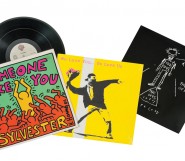Lot #10 - Robert Henry (Bob) Dickerson
-
Auction House:Mossgreen
-
Sale Name:The Peter Elliott Collection
-
Sale Date:30 Aug 2015 ~ 6pm - Part 1 (Lots 1 - 193)
31 Aug 2015 ~ 11am - Part 2 (Lots 194 - 340)
31 Aug 2015 ~ 2pm - Part 3 (Lots 341 - 511)
01 Sep 2015 ~ 10.30am - Part 4 (Lots 512 - 754) and 2pm - Part 5 (Lots 755 - 1013) -
Lot #:10
-
Lot Description:Robert Henry (Bob) Dickerson
(born 1924)
Harlequins 1966
enamel and plaster on board
91 x 121.5 cm
signed lower right: DICKERSON -
Provenance:Rudy Komon Gallery, Sydney
-
Exhibited:Harlequins, Johnstone Gallery Brisbane, 1966, cat. no. 33; Robert Dickerson Retrospective, as The Two Harlequins, Holdsworth Galleries, Woollahra, 1983, cat. no. 198 (illus); Masterpieces from the Peter Elliott Collection - curated by Lou Klepac, Maitland Regional Art Gallery, 6 December 2013 - 7 February 2014, Orange Regional Art Gallery, 2 May - 15 June 2014
-
References:Jennifer Dickerson, Robert Dickerson: Against the Tide, Pandanus Press, Brisbane, 1994, p. 76 (illus); Gavin Fry, The Peter Elliott Collection of Australian Art, The Beagle Press 2013, pg. 87, cat. no. 71
-
Notes:Robert Dickerson grew up in post-Depression poverty in Hurstville, a southern suburb of Sydney and his remarkable life is a testament to stoic determination and an artistic urge that gnawed away at him since childhood. Dickerson is drawn to sociological groupings. The subjects of his paintings are “characters”, often seen as though their varied lives were parts of their own theatre plays. There is a sense that his characters act like marionettes that play their part in society – businessmen, vagabonds, jockeys, clowns, the unemployed, the maimed, the outcast – all are set in context and all are marked by identifying details. Certainly, there is a palpable sense that these masked and grimly depicted characters are the sad and disaffected casualties of Cold War anxiety and Existential uncertainty. Of course, these connections and their related observations are based upon valid ponderings; however, there is another avenue that may lead to a further understanding of Dickerson’s subject matter. The most influential text in the early Sixties was Erving Goffman’s The Presentation of Self in Everyday Life of 1959. Goffman’s famous study analyses the processes of mundane human social interaction in ways that elucidate individual identity, group relations, the impact of context and the interconnected conveying of information. For Goffman, the formation of individual identity arises from semi-rehearsed audience dependant acts of “performance”. These performances have a “front”- a surface veneer; a “setting” - the social context and an “audience” that is formed of ever changing “viewers”. To Goffman’s mind, a type of deeply private impression management system is used by individuals to maintain an elaborately constructed self-presentation. Each person acts to construct, manage and project a social fabrication - a shell of selfhood. Harlequins of 1966 is a remarkably acute sociological observation and fits a different context. His masked and made-up clowns form an analogy of the pressure to conform and the adopting of social veneers. Dickerson “came up” the hard way and there is much about him, and most Australians, that is deeply suspicious of put-ons and poseurs.
-
Estimate:A$30,000 - 50,000
-
Realised Price:
-
Category:Art
This Sale has been held and this item is no longer available. Details are provided for information purposes only.










